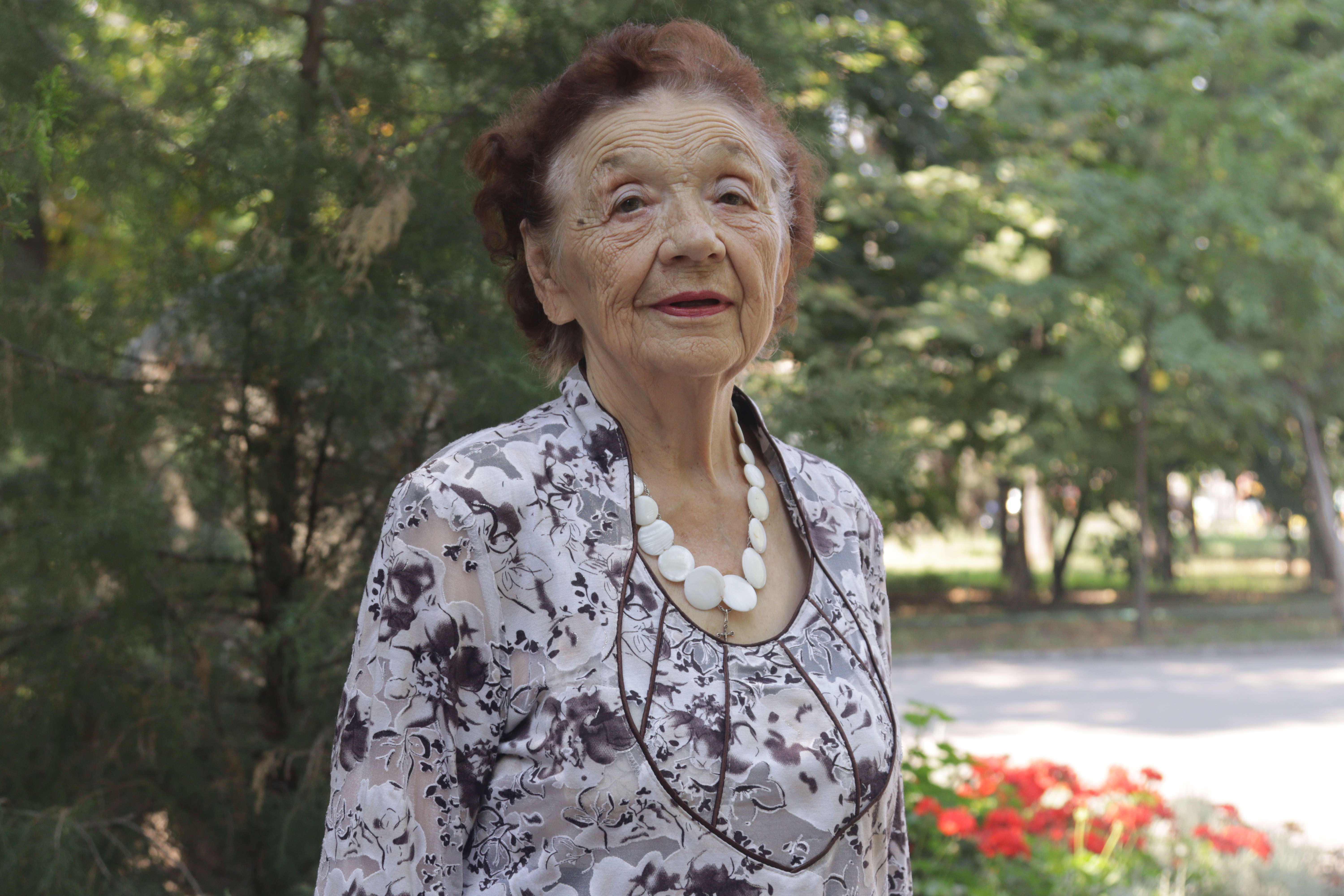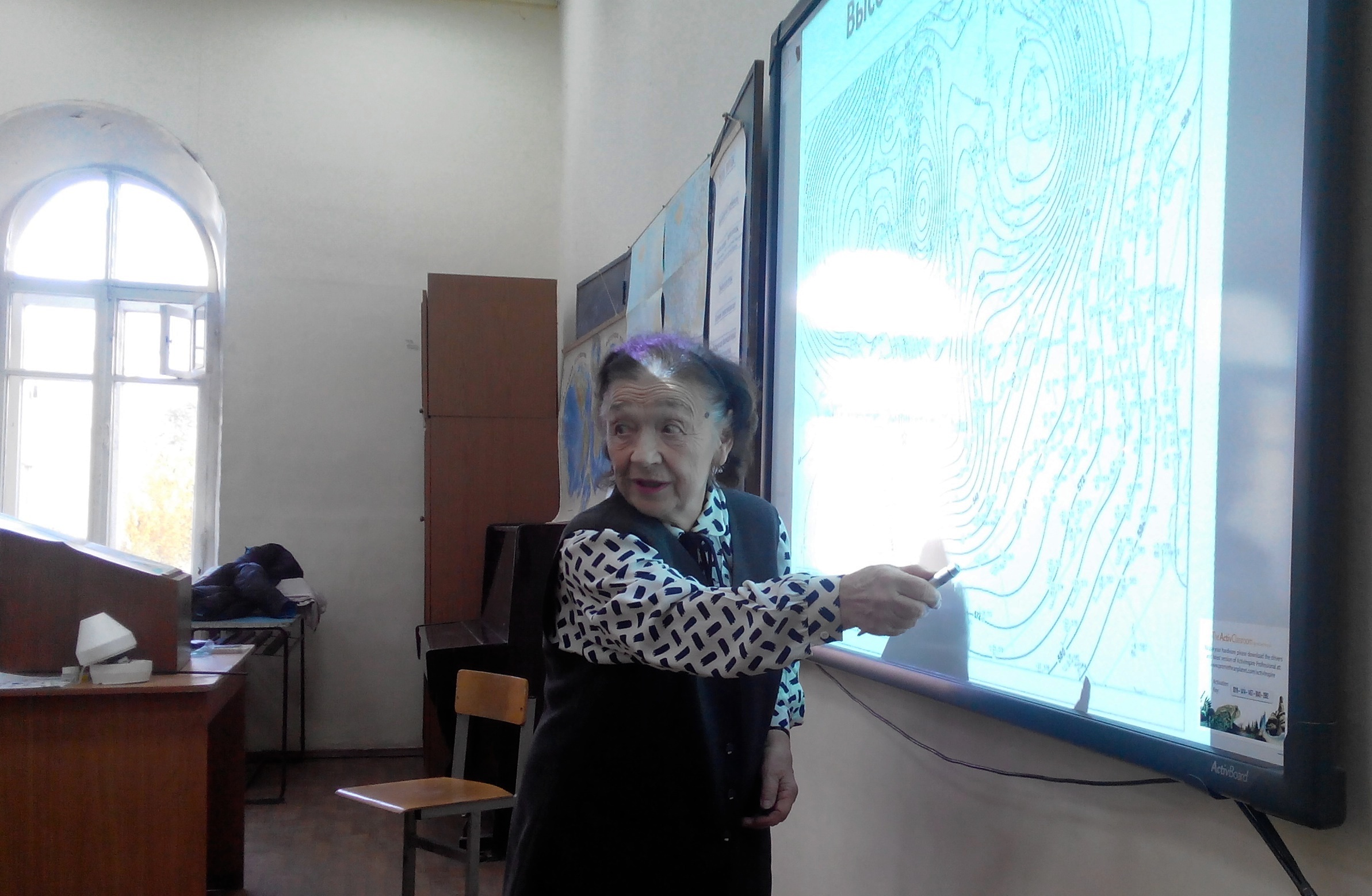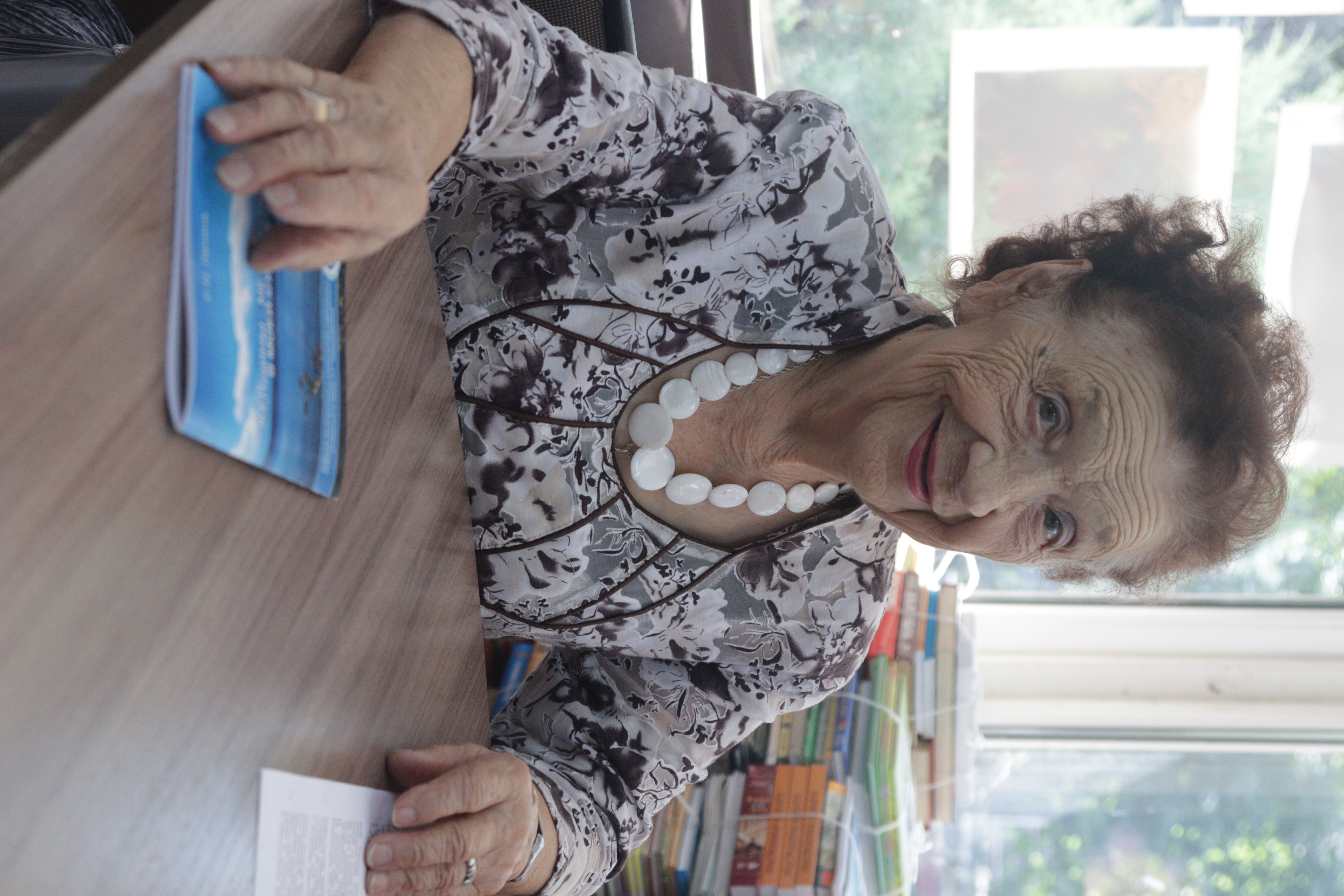Like Stanislavsky, who wrote the book "My Life in Art", associate professor of the Department of Meteorology and Climatology Seraphima Lapina could create a work "My Life in Meteorology". Her service experience is 67 years: first 7 years at the aeronautical meteorological station of Saratov airport, then 60 (!) – at the Faculty of Geography, SSU.
In different periods of her life, synoptic meteorology and medical climatology, climate change and ecology have been the focus of her scientific interests. Today she teaches students economic meteorology. We famously climb with her up the steep stairs to the third floor of the geography faculty. And there would be nothing special about it if it weren't for the fact that my elegant and somewhat even romantic interlocutor turns 90 on August 29.
Seraphima Lapina – Candidate of Geographical Sciences, in different years worked as a senior lecturer, then associate professor of the Department of Meteorology and Climatology. For ten years she was the deputy dean of the geographical Faculty of SSU. For many years he was a scientific secretary of the Head Council for Geographical Sciences. Since 2003 – Member of the Presidium of the SSU Veterans Council. Honorary Worker of education of the Russian Federation.

From Red Hills to White Ponds
– Seraphima Nikolaevna, how did a graduate of Leningrad University end up in Saratov?
– I was born in the Tver (then Kalinin) region, in a town with a beautiful name Red Hill, halfway between Moscow and Leningrad. A classic Russian county town. But it just so happened that graduates of our school for some reason chose Leningrad for further studies. In addition, for my graduation, a parcel was sent to us in the province with a thick avenue of Leningrad University. And since my favorite teacher was a geography teacher, I quickly decided on the choice of faculty. I enthusiastically copied geographical objects from the textbook – continents, peninsulas, oceans. I painted the relief shapes with different colors, since we didn't have contour maps. And I've always really liked to depict cumulus clouds. They attracted my attention like a magnet. Well, isn't that enough? That's how it turned out that my girlfriend and I went to enroll in the geography department of Leningrad University in 1950, having almost no idea about it. But, as they say, I hit the nail on the head right away: this decision has defined my whole life.

The specialty "geographer-climatologist" was chosen by me after the introduction to the subject. But I wasn't wrong here either. We had wonderful practices with trips to the villages of the Rostov region, I was fascinated by observations at a strictly defined time at the meteorological site, where there were many interesting devices. And the first graphic images of the real course of temperatures, wind speed and everything else! This first professional experience finally convinced me of the right choice.
In the 4th year, I got into the Belye Prudy state farm (then it was the Balashovskaya region). We got there from Leningrad as part of the expedition of the Academy of Sciences, by car. They were carrying tents, sleeping bags, food, it was a very difficult 1954...
It was there that I met a young engineer who had just graduated from the Saratov Polytechnic, received a referral to Gorky (now Nizhny Novgorod), but it did not work out to get to him - an all–Union campaign began to send young engineers to state farms as chief engineers. He was sent to the White Ponds, where we met. After graduating from university, I received a diploma of geographer-climatologist, we signed in Leningrad, but while we were returning to Belye Prudy, the position of engineer was reduced. There was no choice, and we went to live with my husband's parents in Saratov.
While studying in Leningrad, our teachers often talked about how they lived and worked during the evacuation at Saratov University during the war. I must say that my training coincided with the period of active activity of many outstanding scientists – meteorologists and climatologists. One of them, Berta Petrovna Karol, the head of my thesis, advised me to contact Elizaveta Vladimirovna Isherskaya, then an associate professor of the department, in Saratov. But there were no places at the university, and she recommended me to contact the Weather Bureau – Saratov Hydrometeorological Center. Alas, there were no vacancies there either. Then I followed one more piece of advice – to write an application to the departmental department, after which I was hired at Saratov Airport as an engineer-forecaster of the aviation meteorological station for aviation maintenance.
Planes First
– And you had to master aviation meteorology from scratch?
–– Of course, because we didn't even have such a course at the university. And the work turned out to be difficult and responsible. No aircraft is released on a flight without a weather forecast at the destination and along the highway. We worked with maps from the Atlantic to the Far East, with encrypted weather received from weather stations. Every hour, at various points at airports, technicians went to observe the weather, took readings of atmospheric pressure, temperature, wind, and so on. Then they transmitted them to Moscow or Kuibyshev, and from there they broadcast them in Morse code. Radio operators put information on the form of a geographical map. And the synoptic group in which I worked processed these parameters and analyzed the entire volume of information.
Here is my working day: I have a departure schedule in front of me, I have to provide pilots with information about the height of clouds along the route before each flight, tell them if there will be precipitation at this time, what wind is expected at a given altitude, and so on. I talked to everyone personally before the flight, advised how best to act in a particular situation.
Then a lot of planes flew around the region. There were few buses, and sometimes roads, too. The mail was delivered by plane. I've flown it myself more than once. One winter, the pilot shouts: look, the horse is already going with the driver for the mail. The plane did not land, but simply dropped bags with letters and parcels, because at some points there were no conditions for landing.
One day the pilot invited me to sit next to him, said: now we will enter the cloud, take it! Well, I took it – stuck out my hand. From this touch, the palm immediately became wet. That's how I greeted the cloud for the first time.
I worked at the airport for 7 years, until 1962. I lived in Agafonovka, almost no one had personal phones then, only one public hung – in the Rodina cinema. I came in one night, let out all the pilots, I already had a son then, lay down to sleep a little, I open my eyes - there's a blizzard outside the window, I run to the phone, ask the attendant: so–and-so is back, and this one, and that one?.. This situation has been repeated many times.
In 1959, through the efforts of Elizaveta Vladimirovna Isherskaya, the Department of Meteorology was opened at our university. A well-known meteorologist Viktor Lvovich Arkhangelsky was invited from Vladivostok, later he became a professor and head of the Department of Meteorology and Climatology.
Elizaveta Vladimirovna invited her graduates to enter graduate school. Some of them worked with me at the airport. The task was to replenish the staff of the newly formed department with highly qualified specialists with work experience. I thought, why don't I try it? I must say that Leningrad university practices have given me a craving for generalizations and analysis. I went with reports to student conferences in Vilnius, in other cities. Therefore, when I read an ad in the newspaper that Saratov University announces a competition for the position of assistant of the Department of Meteorology, I took note of it. Although I already worked as a senior weather engineer, and my salary was increased.
I still keep an extract from the Academic Council of the Geographical Faculty of SSU that I passed the competition. Later it turned out that the experience of working at an aviation meteorological station turned out to be a solid foundation on which I was finally formed as a meteorologist. And most importantly, I have never had any problems with teaching a variety of disciplines of the meteorological cycle at the department. In particular, my favorite aviation meteorology, to which I gave a lot of effort and which I still adore!
When I was already working at the university, a front-line teacher, a former military meteorologist, Colonel Nikolai Georgievich Chugunov, once asked me: do you dream of aviation? I answer: that's not the word, sometimes I wake up in a cold sweat. "That's me too," he admitted…
there is never a dull moment with weather

– Your PhD thesis explores the dynamic characteristics of the climate of the Lower Volga region. What is the reason for the interest in this topic?
– In the 1970s, I was very interested in the research cycle of a major scientist at Moscow University, Boris Pavlovich Alisov. By the way, today geography students study climatology according to his textbooks. While developing an analysis methodology for studying the climate of individual territories of the country, he defined the climate as a "long-term weather regime". He believed that each territory has its own "type of weather". He was interested in the analysis of the recurrence and change of these types, statistics of the modes of meteorological elements characteristic of them. Alisov introduced the concept of "weather geography".
We called him and said that Saratov University also wants to participate in the research conducted by him on the example of the Lower Volga region. He welcomed our initiative, I went to see him in Moscow, together we identified the main tasks, he agreed to be the head of my PhD thesis, and as a result, I was busy for a long time with a comparative analysis of the climate of the Saratov, Volgograd and Astrakhan regions.
– And today, with so many new technologies, have weather forecasters' forecasts become more accurate?
– It's hard to say. Of course, in those days our work looked very different. There was no automation, no computers. We processed the material on paper, with a pencil and an eraser in our hands. Some radio aces immediately put the received data on the map, they had a special pen with two feathers (now it is a museum exhibit), it was dipped in black and red ink (the temperature and thunderstorm were marked in red). The forecast was made based on knowledge of physical processes, local specifics and experience. Now forecasts are made much faster, using various modern equipment and computational methods. Of course, the volume of materials has also increased. What is not being measured today by conducting meteorological, hydrological, actimetric, ozonometric and other observations!
Today there is no need to process cards, the machine does it for you. But innovative technologies do not always work for the benefit. It seems to me that the bias towards digitalization should not cancel out the human factor. Sometimes I ask students returning from practice: have you given advice to pilots? No, they say they see everything on the screen themselves. That is, they use automatic data without specialist adjustments. Then I prove to the guys how important it is to convey the necessary information by word of mouth, analyze the situation, place accents in order to avoid the notorious "pilot errors" that we have been hearing about so often lately.

I will insist that the weather forecaster always has the last word! Despite any modern technologies, the specialist should retain the right to comprehend and analyze the collected material. A competent, experienced specialist in his conclusions brings together all the local conditions, all the most significant geographical features of the area into a single picture. Yes, you don't have to go far: if you compare Saratov and Engels by the frequency of some weather phenomena, for example thunderstorms, then there are always more of them on the right bank, in Saratov, because the water massif makes its own adjustments, a downward movement of air is formed over the Volga. And the amount of precipitation is always more here.
Well, as for the inaccuracy of forecasts, which today it is customary to discuss with irony at the everyday level, then people, as a rule, remember only those cases when the forecast did not work. No one will say: oh, how exactly the weather forecast was justified today! In addition, different weather phenomena can form simultaneously in different parts of the city. It is no coincidence that the word "places" is used in forecasts.
The accuracy of the forecast, of course, is also affected by how much we observe the weather. I am trying to impress this truth on my students. When leaving the house, I always look at the barometer and pay attention to the clouds. And I say to the students: when you go outside, raise your eyes to the sky, please. Look at the clouds today – it's a storehouse of information! If, for example, in winter the sky is covered with a thin veil in the morning and the sun is no longer visible, cirrus clouds prevail, then after some time it will definitely snow. If high-beam clouds with protrusions, or, as they are also called, tower-shaped clouds, are lined up on the horizon in the summer, wait for a thunderstorm.

– Seraphima Nikolaevna, in addition to dozens of scientific articles on meteorology and climatology, you often publish memoirs about your colleagues and teachers. Share your memories in the book "Childhood Scorched by War", published in 2016 by SSU Publishing House. You are the author of the wonderful book "Women meteorologists in my destiny". What inspires you to work in literature?
– I am already so many years old that I ask myself: who else will remember my colleagues if not me?..
Yes, I belong to the generation of children of war. The war started when I just graduated from the first grade. Quite a conscious age to remember this hard times in all the details.
And as for my new book, the premise was the fact that meteorology was one of the first fields of science in which Russian women were given the right to work as research assistants on an equal basis with men since 1913. The first female researchers, geophysicists and meteorologists, were "bestuzhevki" who graduated from the Higher Women's Bestuzhev courses in St. Petersburg. So I wanted to tell you about the scientific and professional activities of those of my female colleagues who met on my life path and remained in my memory for many years. All of them honestly and very effectively served meteorological science!
Tamara Korneva,
photos of Dmitry Kovshov and from the personal archive of the heroine
Material on the topic:
Interview with Seraphima Lapina "Two cities – two universities"







